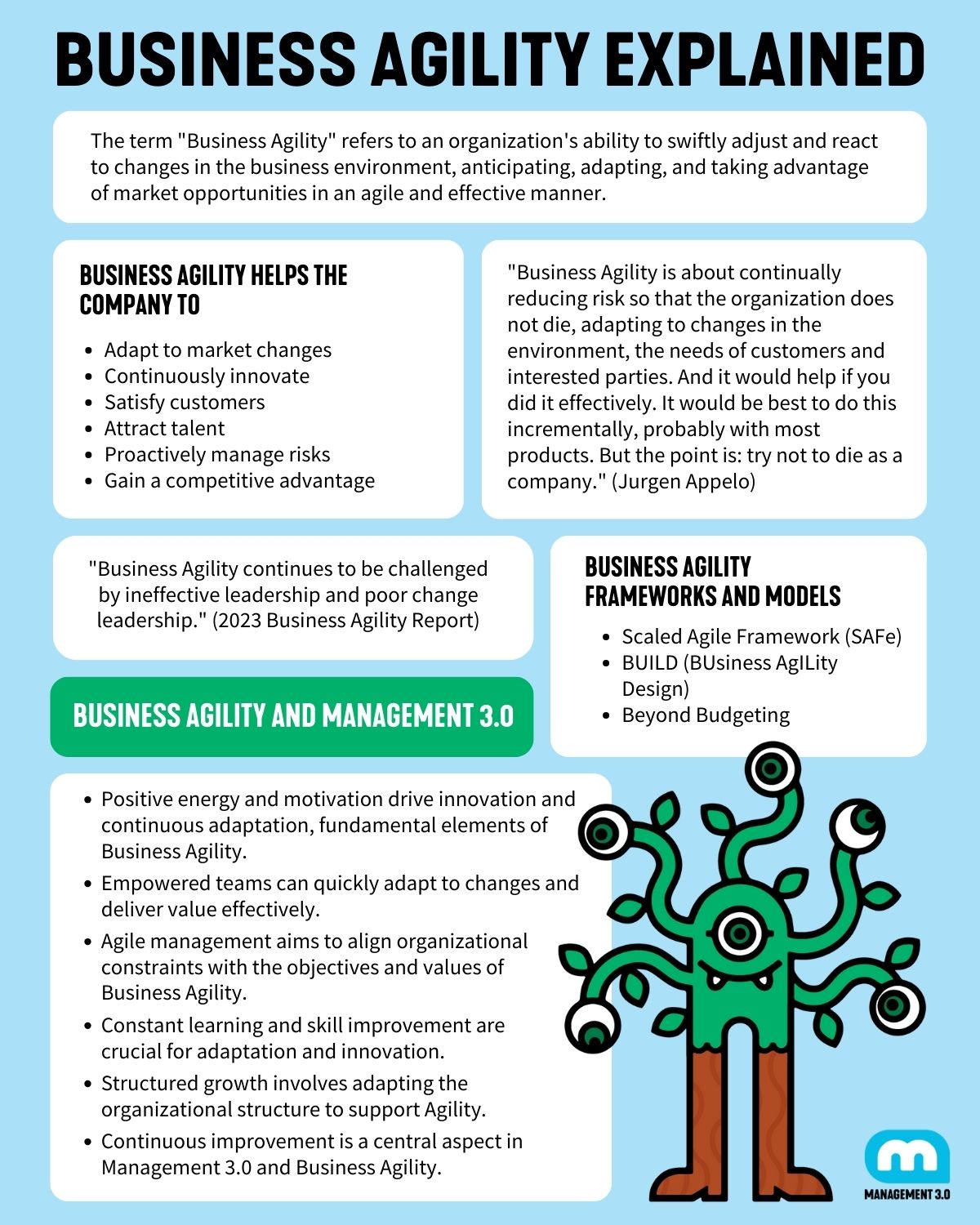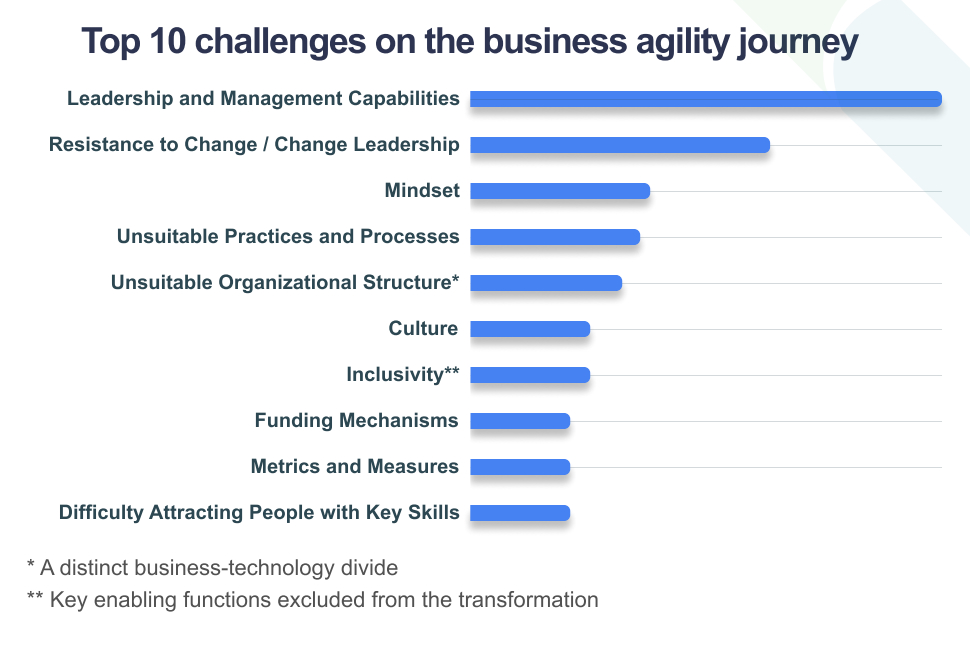Thiago Brant knows that best practices emerge from reflecting on current working methods for improvement and adaptation. He leverages his experience with the mindset, methods, and frameworks in Business Agility to assist managers in creating their own work methods, fostering results in a healthy environment.
I live in beautiful Brazil, where the Agile scene is thriving and expanding each year. Management 3.0 plays a significant role, and I’m proud to be part of this movement. Last year, notable figures from the Agile world visited Brazil, sharing insights on Agile and Business Agility.
What did they say?
- Jurgen Appelo, creator of Management 3.0, emphasized, “Business Agility is about continually reducing risk so that the organization does not die, adapting to changes in the environment, the needs of customers and interested parties. And it would help if you did it effectively. It would be best to do this incrementally, probably with most products. But the point is: try not to die as a company.”
- Arie van Bennekum, an Agile Manifesto signatory, expressed regret for limiting it to software. He highlighted the need for agility across all organizational disciplines like legal, marketing, and finance for true business agility.
- Pia-Maria Thoren, founder of Agile People, after speaking at Agile Brazil, emphasized, “Business Agility is all about People Agility, as businesses are made of people.”
Starting with compelling quotes and perspectives, this article aims to delve deeper into Business Agility, explaining its essence, importance, and how to achieve it.
What is Business Agility? (What does Business Agility mean?)
According to the Business Agility Institute®, “Business Agility is a set of organizational capabilities, behaviors, and ways of working that give your business the freedom, flexibility, and resilience to achieve its purpose, no matter what the future brings.”
Citing Ewerton Santos, a respected figure in Brazil and someone I’ve collaborated with on a significant agile transformation: “In the new economy, organizations need to understand the critical skills that unlock Agility throughout the organization, impacting business results. Leadership plays a vital role in the transformation journey, along with talent preparation and adaptable practices.”
The term “Business Agility” refers to an organization’s ability to swiftly adjust and react to changes in the business environment, anticipating, adapting, and taking advantage of market opportunities in an agile and effective manner. This concept is closely linked to Agility in product development, organizational flexibility, and responsiveness.
Characteristics and Practices Associated with Business Agility
In today’s fast-changing business environment, adopting Business Agility practices can significantly benefit organizations, helping them stay competitive by responding faster and more efficiently to market demands.
These are the key characteristics associated with Business Agility:
- Quick Response to Changes
Agile organizations swiftly identify and respond to market conditions, customer preferences, or external factors. - Collaboration and Transparency
Open and transparent communication is encouraged within the organization and with external stakeholders, promoting effective collaboration for better decision-making. - Continuous Iteration
Agile methods like Scrum and Kanban emphasize iterative and incremental product delivery, allowing for frequent adaptations based on continuous feedback. - Team Empowerment
Agile organizations decentralize decision-making, empowering cross-functional teams to make relevant decisions, fostering innovation and effectiveness.
- Customer Focus
Understanding and meeting customer needs is essential. Agile organizations continuously seek to understand and meet customer expectations. - Continuous Learning
A culture of continuous learning is fostered, encouraging experimentation, reflection on results, and constant adaptation based on lessons learned. - Efficient Risk Management
Agile organizations proactively identify and manage risks, recognizing the inevitability of change.
Why is Business Agility Important?
While Agile transformation has succeeded in software development, it hasn’t permeated the entire company.
The Agile Manifesto, a significant milestone in Agility, originated in software development, leading to what many now refer to as the “Island of Agility”:

Many areas adopt agile practices, yet the company as a whole remains a bureaucratic giant. Amy Kates, Greg Kesler, Michele DiMartino, and Julie Sweet, in their book, “Networked, Scaled, and Agile: A Design Strategy for Complex Organizations,” point out the challenges of “agile business units” unable to work together for a complete customer experience.
To address this, focusing on Business Agility is crucial.
Achieving true Business Agility helps the company
- Adapt to market changes
- Continuously innovate
- Satisfy customers
- Attract talent
- Proactively manage risks
- Gain a competitive advantage
Challenges for Business Agility
Implementing and maintaining Business Agility pose challenges, involving significant cultural, process, and organizational changes.
These challenges include:
- Cultural Change
Transitioning to an agile culture requires a profound shift in mindsets and practices, facing resistance, lack of understanding, and insufficient leadership support. - Leadership and Sponsorship
Leadership plays a crucial role, and lack of support can lead to implementation failures. Leaders need to understand, support, and practice agile principles. - Integration with Traditional Structures
Integrating agile practices into existing structures can be challenging, leading to conflicts between agile and traditional methods. - Capability Building and Training
Lack of skills and knowledge about agile can be an obstacle, emphasizing the need for ongoing training. - Ineffective Communication
Inadequate communication can result in misunderstandings, resistance, and lack of alignment, highlighting the importance of transparency.
- Integration of Multidisciplinary Teams
Forming multidisciplinary teams can be challenging, requiring effort and cooperation to overcome organizational silos. - Performance Measurement and KPIs
Establishing agile-aligned key performance indicators (KPIs) challenges traditional metrics, requiring a shift in measuring success and progress. - Scalability
As agile adoption grows within an organization, scaling can be a challenge. Ensuring that agile practices are scalable to meet the entire organization’s needs is a common concern. - Change Management
Implementing Business Agility involves significant organizational change, requiring effective management, including identifying and mitigating resistance. - Maintaining Long-Term Agility
Maintaining an agile mindset over time is challenging, requiring continuity and adaptability in the face of external pressures or leadership changes.
Overcoming these challenges demands sustained commitment, strong leadership, ongoing education, and an iterative approach to adjusting practices as needed. Recognizing that Business Agility is an ever-evolving process is essential, and successful organizations are willing to learn, adapt, and continuously improve.
Business Agility Frameworks and Models
There are various approaches to instilling Business Agility in companies, encompassing multiple frameworks and models designed to expedite this process. Among them, notable examples include:
Scaled Agile Framework (SAFe)
SAFe, or Scaled Agile Framework, stands out as the most widely used framework for scaling agility. It was specifically developed for large-scale agility, evolving to embrace Business Agility.
SAFe is inspired by the concept of Business Agility capabilities and provides seven core competencies to attain it:
- Team and Technical Agility: Focuses on the ability of development teams to deliver value in an agile, high-quality manner, incorporating agile practices, engineering, and collaborative working methods.
- Agile Product Delivery: Involves developing, delivering, and always being ready to launch products and solutions in short, regular cycles, ensuring quick adaptation to changing customer needs.
- Enterprise Solution Delivery: Concentrates on coordinating and delivering large solutions and systems involving multiple agile teams, emphasizing efficient integration and continuous delivery of customer value.
- Lean Portfolio Management: Applies Lean and Agile principles in portfolio management, aligning strategies and investments with agile delivery, and enabling value-based decision-making.
- Organizational Agility: Involves adapting culture and organizational structure to support agile principles, encompassing leadership, mindset, and practice changes to create a more agile organization.
- Continuous Learning Culture: Focuses on promoting a culture of constant learning and continuous improvement at all levels of the organization, incorporating the ability to learn from mistakes, feedback, and experiences to drive innovation and evolution.
- Lean-Agile Leadership: Encompasses developing agile leaders at all levels of the organization, empowering them to lead transformation, inspire and motivate teams, promote an agile culture, and make effective decisions in complex environments.
A potential side effect of adopting SAFe is the perpetuation of the agile island concept mentioned above. Lean Portfolio Management acts as a “resource allocation bridge,” connecting the “main island of bureaucracy” with the “island of agility,” according to Beyond Budgeting (discussed below).
BUILD (BUsiness AgILity Design)
BUILD, created by Alexandre Magno, a leading pioneer of Agility in Brazil, introduces a model based on Scaffolds instead of Frameworks. Scaffolds are temporary structures applied in the organization to adapt and consolidate new practices. They are not incorporated into the organization’s processes but serve to aid in adapting processes. The model consists of three steps:
- Brief: Conduct an initial assessment of the organization’s current state, define specific objectives and agile transformation goals, and identify stakeholders.
- Sense: Engage in benchmarking activities to understand industry best practices, conduct a detailed analysis of the organization’s internal and external environment, and educate stakeholders about the principles and benefits of Business Agility.
- Design: Create a shared vision, align goals across the organization, develop an implementation strategy considering organizational culture, structure, and processes, and implement agile practices starting with pilot teams and gradually expanding across the organization.
Beyond Budgeting
Beyond Budgeting presents an alternative management approach to the traditional annual budgeting process. It aims to overcome limitations associated with conventional budgeting methods, fostering greater adaptability to dynamic business environments. This approach, emerging even before the Agile Manifesto in 1998, works on a modern vision of business necessary for differentiation in a scenario where business and operational models no longer distinguish a company.
Key principles of Beyond Budgeting include
- Replace Budgets with Objectives and Targets: Establish clear objectives and goals instead of fixed annual budgets, allowing teams more freedom to seek effective solutions.
- Decentralization of Authority: Favor decentralization, enabling local teams to make more autonomous decisions in response to changing market conditions and customer needs.
- Relative Performance Instead of Absolute Targets: Focus on outperforming competitors and continually improving relative performance rather than achieving specific budgetary targets.
- Accountability and Transparency: Assign greater responsibility to teams and individuals, emphasizing transparency about performance and results.
- Continuous Feedback and Learning: Promote a culture of continuous learning, encouraging experimentation, constant feedback, and rapid adaptation.
- Leadership and Shared Values: Encourage leaders to adopt a leadership style that inspires trust, promotes collaboration, and aligns with shared values.
The core idea of Beyond Budgeting is to create more agile, adaptive, and value-focused organizations by replacing the emphasis on fixed budgets and rigid hierarchies with a flexible, principles-driven approach. This approach is especially relevant in volatile business environments where rapid responsiveness is essential to organizational success, addressing the agile island effect mentioned earlier and connecting the organization’s core strategy to its operations.
Business Agility and Management 3.0
In light of what we’ve discussed so far, one question remains: how does Management 3.0 connect to Business Agility?
The role of leaders in embracing Business Agility and Management 3.0 is all about redefining management and leadership. Management 3.0 lays a strong foundation for the mindset needed for managers to welcome this change.
All six management views contributed, in some way, to a more agile business:
- Energize People – Energized individuals are more likely to engage in agile transformation and embrace change. Positive energy and motivation drive innovation and continuous adaptation, fundamental elements of Business Agility.
- Empower Teams – Giving teams the authority to make decisions and take responsibility makes the organization more agile. Empowered teams can quickly adapt to changes and deliver value effectively.
- Align Constraints – Agile management aims to align organizational constraints with the objectives and values of Business Agility. This allows the organization to operate within known constraints while maintaining the flexibility to innovate and adapt.
- Develop Competence – The continual pursuit of skills development is essential to face challenges and opportunities in the agile context. Constant learning and skill improvement are crucial for adaptation and innovation.
- Grow Structure – Structured growth involves adapting the organizational structure to support Agility. This may include introducing agile practices, such as decentralization of decisions and lighter structures, to facilitate a rapid response to changes.
- Improve Everything – Continuous improvement is a central principle in Management 3.0 and Business Agility. The constant search for ways to enhance processes, practices, and results is fundamental to both approaches.
Overall, Management 3.0 views align with the principles of Business Agility, fostering a culture of learning and adaptation, and focusing on people creating agile and effective organizations. Both approaches aim to create environments where teams can thrive, innovate, and adapt in an ever-evolving business world.
Management 3.0 brings the mindset that leadership can effectively act on these pillars when seeking Business Agility and lead by example, an essential ingredient of an agile organization.
It connects well with the SAFe competency on Lean-Agile leadership and has a consistent parallel with the management practices brought by Beyond Budgeting.

There is no doubt that companies need to consider Business Agility. The significant challenge is understanding how not to waste resources on unsuccessful transformations, which often reduce Agility instead of increasing it. Much focus has been given to adopting squads as a path to organizational Agility, but we know this is not the leading solution.
As outlined earlier, we need to:
- Continually reduce risk.
- Adapt to changes in the environment and the needs of customers and stakeholders.
- Feed ourselves with information from the environment as quickly as possible.
- Do it effectively.
- Interactively and develop our products incrementally.
- Try not to die as a company.
And, of course, focus on the essential change in the mindset and development of our leaders, who will guide the organization along this path.
According to the latest “Business Agility Report” from the Business Agility Institute, “Business Agility continues to be challenged by ineffective leadership and poor change leadership.”
I hope this article can provide some insights and paths to this! I did not intend to provide a definitive answer to “how to make our business more agile” because I do not believe such an answer exists. Instead, I planned to elucidate the possibilities and facilitate the process.



